Knowing when to plant vegetables is essential if you’re looking to grow your own edibles. Growing your own vegetables from seed is a great way to give a supply of fresh organic produce as part of a healthy diet, but it is also highly rewarding and good for wellbeing.
While you can buy seedlings and plug plants from garden centres and online suppliers, planting vegetables from seed is the most economical way of growing produce, plus it also offers the opportunity to try all sorts of different vegetable varieties. However, with a dazzling array to choose from, it can be tricky to know where to begin.
Whether you’re in the process of creating a kitchen garden or simply want to grow a few veggies in containers on your patio or balcony space, this handy vegetable calendar will help get your kitchen garden ideas get off to the best start.
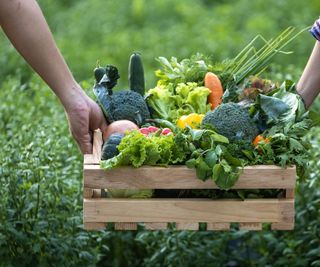
(Image credit: Getty Images/Akarawut Lohacharoenvanich)
When to plant vegetables – points to consider
vegetable garden ideas, plus there are vegetables that can be planted every month of the year, right through from January to December.
A vegetable calendar is a great place to start when planning a kitchen garden as it will help you know when to buy seeds so that you don’t miss out on growing your favorite vegetables. It is also a handy source of inspiration for what to plant.
The temperature of the soil is a key factor in the germination of seeds, and different seeds germinate at different temperatures, so consider buying a soil thermometer to check if the temperature is right for sowing.
Different varieties of the same type of vegetable can have different sowing and planting times, so always refer to the instructions on the seed packet.
January

(Image credit: GettyImages/Andrew Linscott)
With the ground still very cold, January is a quiet time for sowing and planting vegetables, so this is the perfect opportunity to plan for the year ahead. Take time to look through seed catalogues and make a plan for your plot.
However, there are some things that can be planted undercover to get your growing season off to a head start.
Onions – if growing from seed then onions can be planted under cover in a greenhouse in January and February. While growing onions from sets (immature onion bulbs) is often the easiest method, knowing how to grow onions from seed may be useful as it is a more economical way of growing them if you are looking for a larger crop.
Potatoes – For those keen on learning how to grow potatoes then January is the time when you can begin the process by chitting your Early potato varieties. Chitting encourages potatoes to sprout before planting and is usually done 6 weeks before seed potatoes are planted into beds.

Walla Walla Sweet Onion

Red Creole Onion

Yukon Gold Potato
February

(Image credit: Crocus)
The weather is unpredictable but there are some vegetables that can be planted in February under cover in the greenhouse or on a warm windowsill to kick start the growing season including hardy vegetables.
Edibles that need warmth and are suited to growing in a greenhouse can also be planted under cover in February including tomatoes, peppers, cucumber and eggplant.
With spring around the corner, February is a good time to prepare your beds for the growing season. You can also cover them with a plastic tarpaulin or cardboard to prevent the soil getting waterlogged.
What to plant indoors:
Fava beans – grow fava beans, also known as broad beans, by sowing them indoors into individual pots or modular trays ready for planting out 4-6 weeks later. Alternatively sow directly from March to May or in October to November for an early spring crop. You can also sow directly in February under cloches.
Tomatoes – sow tomatoes in a propagator in late February – this is the best time to sow if you are thinking of growing tomatoes in a greenhouse. Sow in seed trays or in individual pots if you want just a few plants.
Peppers – sow under cover from February until March. Sow seeds into pots or seed trays and place in a heated propagator 65–70°F (18–21°C) or on a sunny window sill covered with a plastic bag.
Eggplant – growing eggplant – or aubergines – in a greenhouse sow seeds in individual pots in February and plant out in April. Alternatively sow from January for cultivation in a heated greenhouse. If transplanting outside, sow seeds undercover in March and plant out once the risk of frost has past in later May.
What to sow outdoors:
Radish – sow seeds direct where they are to grow in short drills 12 inches (30cm) apart from February until August. Sow little and successively for a continual supply. If sowing in February consider using a cloche.
See the range of radish seeds at True Leaf Market

Broad Windsor Fava Bean
March

(Image credit: Getty Images/Trudie Davidson)
In milder regions and areas with light, sandy soil, March is the time when you can begin to sow some vegetable seeds outside. Sandy beds will benefit from the addition of organic matter to help the soil retain moisture. In cooler regions, and areas with heavy clay soil, outdoor sowing may be a little later. You can also continue to sow tomato, eggplant and peppers undercover.
What to sow indoors:
Pumpkin – sow under cover from March until May or sow direct from late May once frosts have passed.
Cucumber – if you are planning to cultivate cucumbers a greenhouse sow seeds now ½–¾in (1–2cm) deep, in small pots. Be sure to familiarise yourself with how to grow cucumbers before you start out.
Tomatoes – sow seeds under cover in March if you are planning to transplant them outside.
What to sow outdoors:
Asparagus – plant asparagus crowns in late March and April.
Beetroot – direct sow in rows 12 inches (30cm) apart from March to July for harvesting in as little as 7 weeks. Thin out seedling to 4 inches (10cm) apart at about 1 inch (2.5cm) tall. Sow every few weeks for continual supply.
Fava beans – sow seeds direct outside into rich fertile soil enriched with manure or organic matter. Sow in seeds at 9 inch (23cm) intervals in double rows set 9 inches (23cm) apart, with 24 inches (60cm) between each double row. Be sure to familiarise yourself with how to grow fava beans beforehand.
Leeks – sow leeks in March and April in a prepared seed bed for transplanting to their final position in early summer. Alternatively they can be sown under cover from January to March in modules and placed in a propagator ready for planting out later. Harvest from October to March.
Onions – plant onion sets from mid March to mid April. Alternatively plant from October and November.
Parsnips – direct sow from March to May in a prepared bed in a sunny position. The soil should be friable and stone-free.
Peas – sow peas direct from March until July for picking from July to October. To grow them outdoors sow in trenches 2 inches (5cm) at around 3 inches (7.5cm) apart.
There are three types of pea: Early, Second early and maincrop peas, and each is best planted at different times so be sure to research how to grow peas before starting out.
Potatoes – plant chitted First Early potatoes in mid-late March ready for harvesting in 11-13 weeks. When to plant potatoes will depend on what variety they are so be sure to do your research first.
Spinach – sow summer spinach direct from March to June. Sow every three weeks for picking from May to October. Sow thinly in drills 1inch (2.5cm) deep set 12 inches (30cm) apart.
Spring Onion – sow seeds direct from March until August. Sow thinly in drills every three weeks for a continual supply. Spring onions can be harvested in just 8 weeks from sowing.

Burpless Beauty Cucumber

San Marzano Tomato

Jack O Lantern Pumpkin
April

(Image credit: Future)
April is a busy month in the vegetable garden as it is when the outdoor sowing season gets into full swing.
Be sure to label your sowings with the vegetable variety and date as you go. If sowing direct avoid treading on freshly dug soil, instead use boards to stand on.
What to plant indoors:
Zucchini – you can grow zucchini by sowing zucchini seeds in 3 inch (7.5cm) pots and place in a propagator or on a sunny windowsill.
Sweetcorn – for best results sow sweetcorn seeds under glass in mid April and early May and plant out in late May to early June.
To avoid root disturbance sow in 3 inch pots, sow two seeds about one inch deep. Alternatively sow outdoors in mid May – sow in blocks with 2 seeds every 18 inches and 1 inch deep.
What to plant outdoors:
Broccoli – to grow broccoli, sow direct outdoors from May to April. Sow where they are to grow or alternatively sow in a seedbed or under cover, and transplant them to their final position 5-7 weeks after sowing.
Carrots – If you’re wondering how to grow carrots, April is the month to start sowing the seeds outdoors – sow thinly ½in (1cm) deep in rows 6–12in (15–30cm) apart. Ensure the soil is well dug over and raked to a fine tilth – it needs to be free from stones as this can result in forked carrots.
‘For sweet, small carrots, sow every few weeks from early spring to late summer for a successional harvest from June to November,’ says gardening expert Leigh Clapp.
Alternatively, for an early crop, sow varieties such as ‘Nantes’ under cloches or in the greenhouse in February and March.
Cabbage – sow winter cabbage April and May. Transplant seedlings to their final position in late June to July and when the plants have 5-6 true leaves.
Cauliflower – sow outdoors in April for transplanting in June. There are three types of cauliflower – spring, summer and autumn and sowing times will vary on what type you choose to grow.
Chard – chard, also known as beet leaf, is a tasty and versatile hardy biennial that can be sown direct from March to September however sowings in April and July are a good way to ensure a continual crop throughout the year.
‘For great-value yielders you can’t beat Swiss chard and perpetual spinach that will crop for a whole year and throughout winter,’ says gardening expert Leigh Clapp.
Potatoes – plant Second Early potatoes in early to mid April and maincrop potatoes in mid to late April.
Salads and lettuce – direct sow rocket, salads and summer lettuce. Or sow from March under cloches.

Zucchini Black Beauty

Golden Bantam 12 Corn

Tendersweet Carrots
May

(Image credit: Danita Delimont/Alamy Stock Photos)
May continues to be a busy month for sowing vegetable seeds. From mid-May the risk of frost in the UK has usually passed, meaning you can begin to direct sow half-hardy annuals and begin to harden off tender vegetables grown under cover ready for planting outside including courgettes, pumpkin and French beans.
Hardening off is where tender plants are gradually brought outside to acclimatise them to cooler temperatures. If raised in a heated greenhouse, move plants to an unheated greenhouse for around two weeks before then moving them to a cold frame.
If you do not have a greenhouse or cold frame then move the plants outside into the sun for a couple of hours during the day and slowly increase the time period.
You can continue to direct sow broccoli, cabbage, carrot, parsnip, peas and spinach.
What to plant outdoors:
French beans – direct sow French beans from May when the risk of frost has passed, or sow under cover from March for transplanting later. Make successive sowings until the end of June for picking until early October.
You’ll know when to pick green beans and French beans by the appearance of the crop. The beans should be pencil thin, around 4 inches long, and without any visible bumps along the pod.
Zucchini – direct sow zucchini outside in late May to June. Plant out zucchini grown under cover from late May but be sure to harden them off beforehand.
Pumpkin – to grow pumpkins, direct sow pumpkin seeds where they are to grow in late May or early June. Pumpkins grow best in warm weather so cover with cloches to give them the best start.
June
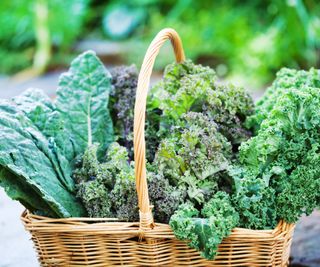
(Image credit: Getty/YinYang)
In June you can continue to make successive sowings of radish, salad and carrots, as well as direct sow zucchini, beetroot, peas, French beans and parsnips.
What to plant outdoors:
Fennel – Sow seeds direct in late June in fertile, moist soil. Thin to one plant every 10in (25cm) in rows 18in (45cm) apart, and water during dry spells. See the range of fennel seeds available at Burpee
Brassicas – direct sow brassicas such as kale, cabbage, broccoli and Brussels sprouts for harvesting in winter
July

(Image credit: Getty/Melissa Ross)
July is the last chance to sow French beans and you can also plant out winter leeks into their final position. Fast-growing vegetables can still be sown including radish, spring onions and beetroot.
There is plenty of harvesting to be done in July which will keep you busy including, carrots, radish, beetroot, chard, peas, salad leaves, fava beans, tomatoes, cucumbers and more!
What to sow outside:
Chard – Sowing a second crop of chard in July will give you a fresh supply through autumn. Sowings made in July can also be overwintered for picking the following spring.
Spring cabbage – sow spring cabbage in July and August in seed beds and transplant to their final position in September and October ready for picking the following spring.
Pak choi – great in soups and salads and easy to grow from seed, pak choi can be harvested in as early as 30 days in baby leaf form or in 45-70 days as semi-mature to full size heads.
They can be grown outside over winter, providing you with fresh greens all the way through to spring but will benefit from some protection. Sow seeds thinly at a depth of 1/2 an inch (1cm) in rows 15 inches (38cm) apart. The seedlings will need thinning to different distances depending on how mature you want to grow your pak choi.
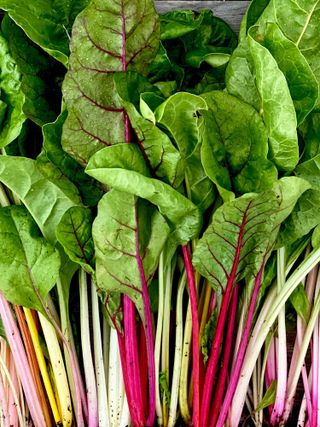
Swiss Chard Bright Lights
August
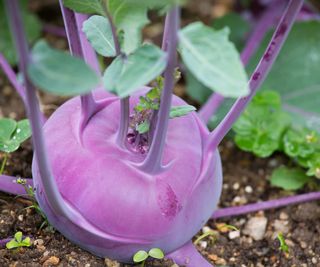
(Image credit: Cuson / Shutterstock)
In August your vegetable plot will be at its peak with a glut of produce ready for harvest, however there are some things you can plant, including winter crops such as spinach, kohl rabi, and spring cabbage as well as winter salad leaves.
What so plant outside:
Spinach – late August is a good time to sow a second crop of spinach.
Spinach is a cool season crop which can easily go to seed in the heat, so seeds are best grown in early spring as well as in late summer and early fall.
It can also be over wintered with protection. For later sowings look for ‘long-day’ varieties. Check out how to grow spinach for more tips.
Kohl rabi – If sown in August this brassica can be harvested up until November. Sow direct in drills 12 inches (30cm) apart and at a depth of ½in (1cm) deep. Thin out seedlings at 1in (2.5cm) tall to a final spacing of 6in (15cm) apart and keep well watered in hot weather. Pick when between the size of a golf and tennis ball. You can get kohl rabi seeds at True Leaf Market.
September
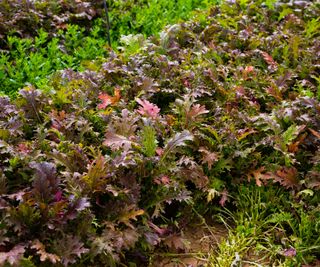
(Image credit: Getty Images/JackF)
Winter salads – there are many hardy salads that will grow over winter including Lamb’s lettuce, mustard greens, ‘Winter Gem’ lettuce, arugula and oriental leaves such as mibuna and mizuna.
Early fall is the perfect time to sow these as the soil is still warm. Seeds can be sown in seed trays or direct into finely raked soil.
You can also continue to make sowings of chard.
October
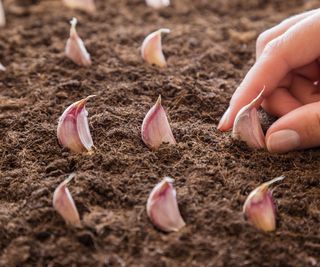
(Image credit: Getty/FotoDuets)
What to plant outside:
Garlic – October is when you can start growing garlic. Garlic is often grown from sets rather than seed and is best planted in autumn as it needs a cold spell to stimulate growth. However there are varieties that can be planted in early spring.
Sets should be purchased from garden centres or specialist mail order suppliers and not from the supermarket. There are two main sorts to choose from: hardneck and softneck.
To sow, split the bulb into cloves and plant in rows 4-6 inches (10-15cm) apart, 1 inch (2.5cm) deep with the pointed end facing up.
Garlic can rot in waterlogged soil so if you have heavy clay soil consider starting them off in modules, finding out more on how to grow garlic will ensure your crop is a success.
Fava beans – if your vegetable garden is in a sheltered position early varieties of fava beans can be planted direct in October for an early crop the following year.

Italian Late Garlic
November

(Image credit: Getty Images)
As the temperature drops there are little sowings that can be made in November, but there is still plenty of edibles to harvest including brassicas such as kale, cabbage, Brussels sprouts and kalettes.
Root vegetables can be lifted including the last of the carrots, parsnip, beetroot and celeriac, plus hardy salad leaves can be picked.
Asparagus – while the crowns are traditionally planted in spring, you can grow asparagus by planting in fall, too, to help give the crop a head start.

Mary Washington Asparagus
December
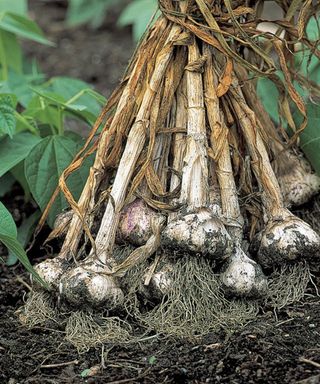
(Image credit: RHS/Georgi Mabee)
December is a good time to plan what you are going to grow in the year ahead and crisp winter days can be a good opportunity to prepare the soil for the coming growing season. Take notes of what worked well and plan crop rotations for the year to come.
Winter salad – seeds of mustard greens, mizuna, corn salad, lambs lettuce and ‘Winter Gem’ lettuce can be grown outside in a cold frame or unheated greenhouse. If you live in a mild area you can grow them in the ground and use cloches to protect them if temperatures dip dramatically.
Garlic – December is the last chance to plant fall garlic varieties.
If you live in a mild climate and you have free-draining soil sets can be planted directly – they do not grow well in waterlogged soils.
FAQs
What month do you plant vegetables?
There are vegetables that can be planted right through the year from January to December. Using a vegetable planting calendar is a handy tool for planning when to plant vegetables, but ultimately what month you plant vegetables will depend on your climate and growing zone, as well as the last frost date in your area.
Generally March and April, when the soil begins to warm, are the best months to begin sowing many hardy annual vegetable seeds outdoors including broccoli, cabbage, chard, carrots, peas and parsnips. Some of these can be started off under cover in a greenhouse or on a sunny window sill from February to help give them a head start, ready for planting outside once the weather warms.
Vegetables suited for growing in a greenhouse such as tomatoes, peppers, aubergines, tomatoes, cucumbers and chilli peppers can also be planted undercover from February.
From March, frost-tender, half-hardy vegetables can be started off under cover ready for transplanting once the risk of frost has passed including zucchini, pumpkin, sweetcorn and eggplant. After this time, generally from late May and June, frost tender half-hardy annual vegetables can then be planted out into their final position or sown directly outside.
Successive sowings of many fast-maturing vegetables can be sown from March up until July, including radish, beetroot and spring onions.
In July and August many hardy vegetables can be planted for winter harvesting including cabbage, pak choi, spring cabbage, spinach and chard.
The growing season slows from October when temperatures begin to dip but this is the prime time to plant garlic. Winter salads can continue to be planted and fava beans can be sown for an early spring crop.
Growing vegetables is a rewarding hobby and the joys of picking homegrown vegetables are very satisfying. Whether you grow in a few containers or have an entire vegetable garden, remember to use this guide to help you plan and plant your crops.
Source: homesandgardens.com

Leave a Reply